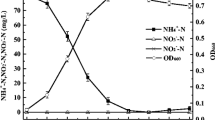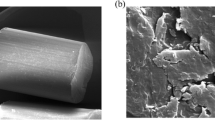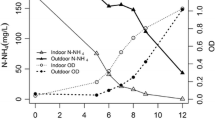Abstract
The growth rate and desulfurization capacity accumulated by the cells during the growth of Pseudomonas putida KTH2 under different oxygen transfer conditions in a stirred and sparged tank bioreactor have been studied. Hydrodynamic conditions were changed using different agitation conditions. During the culture, several magnitudes associated to growth, such as the specific growth rate, the dissolved oxygen concentration and the carbon source consumption have been measured. Experimental results indicate that cultures are influenced by the fluid dynamic conditions into the bioreactor. An increase in the stirrer speed from 400 to 700 rpm has a positive influence on the cell growth rate. Nevertheless, the increase of agitation from 700 to 2000 rpm hardly has any influence on the growth rate. The effect of fluid dynamics on the cells development of the biodesulfurization (BDS) capacity of the cells during growth is different. The activities of the intracellular enzymes involved in the 4S pathway change with dissolved oxygen concentration. The enzyme activities have been evaluated in cells at several growth time and different hydrodynamic conditions. An increase of the agitation from 100 to 300 rpm has a positive influence on the development of the overall BDS capacity of the cells during growth. This capacity shows a decrease for higher stirrer speeds and the activity of the enzymes monooxygenases DszC and DszA decreases dramatically. The highest value of the activity of DszB enzyme was obtained with cells cultured at 100 rpm, while this activity decreases when the stirrer speed was increased higher than this value.






Similar content being viewed by others
Abbreviations
- a j :
-
Activity of enzyme j \( \left( \rm{\mu M \ g_{{C_{X} }}^{ - 1} \ min^{ - 1} } \right) \)
- BDS:
-
Biodesulfurisation
- C* :
-
Oxygen concentration in equilibrium (mol L−1)
- Cj :
-
Concentration of compound j \( \left( \rm{\mu M \ L^{ - 1} } \right) \)
- CO2 :
-
Oxygen dissolved concentration (% or mol·m−3)
- C X :
-
Concentration of biomass \( \left( {g_{X} \cdot L^{ - 1} } \right) \)
- D:
-
Stirrer diameter (m)
- DBT:
-
Dibenzothiophene
- DBTO:
-
Dibenzothiophene sulfoxide
- DBTO2 :
-
Dibenzothiophene-sulfone
- F:
-
Fischer statistical parameter
- HBP:
-
2-Hydroxybiphenyl
- HBPS:
-
2-Hydroxybiphenyl-2-sulfinic acid
- k L a :
-
Volumetric oxygen mass transfer coefficient (s−1)
- N:
-
Stirrer speed (rpm)
- OTR:
-
Oxygen transfer rate (mol O2L−1s−1)
- OUR:
-
Oxygen uptake rate (mol O2L−1s−1)
- Re :
-
Impeller Reynolds number (–)
- SSR:
-
Sum of square residuals
- T :
-
Vessel diameter (m)
- t :
-
Time (min, s or h)
- V :
-
Volume (m3)
- Xj :
-
Conversion or yield of compound j (–)
- η :
-
Effectiveness factor for growth (–)
- µ :
-
Specific growth rate (h−1)
- G :
-
Relative to gas phase
- L :
-
Relative to liquid phase
- Max:
-
Referred to maximum value
- O2 :
-
Referred to oxygen
- X :
-
Referred to biomass
- 0:
-
Referred to initial value
- t :
-
Referred to time of 120 min of resting cell assay
- 0:
-
Referred to initial value
References
Garcia-Ochoa F, Gomez E (2009) Bioreactor scale-up and oxygen transfer rate in microbial processes: an overview. Biotechnol Adv 27:153–176
Märkl H, Bronnenmeier R, Wittek B (1991) The resistance of microorganisms to hydrodynamic stress. Int Chem Eng. 31:185–197
Sahoo S, Verma RK, Suresh AK, Rao KK, Bellare J, Suraishkumar GK (2003) Macro-level and genetic-level responses of bacillus subtilis to shear stress. Biotechnol Prog 19:1689–1696
Chisty Y (2010). In: M.C. Flickinger (ed) Shear Sensitivity in Encyclopedia of Industrial Biotechnology: Bioprocess, Bioseparation, and Cell Technology. John Wiley & Sons, New York
Hodaifa G, Martinez ME, Orpez R, Sanchez S (2010) Influence of hydrodynamic stress in the growth of Scenedesmus obliquus using a culture medium based on olive mill waste water. Chem Eng Process 49:1161–1168
Calik P, Yilgör P, Ayhan P, Demir A (2004) Oxygen transfer effects on recombinant benzaldehyde lyase production. Chem Eng Sci 59:5075–5083
Olmos E, Mehmood N, Haj-Husein L, Goergen JL, Fick M, Delaunay S (2013) Effects of bioreactor hydrodynamics on the physiology of Streptomyces. Bioprocess Biosyst Eng 36:259–272
Prokop A, Bajpai RK (1992) The sensitivity of biocatalysts to hydrodynamic shear stress. Adv Appl Microbiol 37:165–232
Hewitt CJ, Boon LA, McFarlane CM, Nienow AW (1998) The use of flow cytometry to study the impact of fluid mechanical stress on Escherichia coli W3110 during continuous cultivation in an agitated bioreactor. Biotechnol Bioeng 59:612–620
Meijer JJ, ten Hoopen HJG, van Gameren YM, Luyben KChAM, Libbenga KR (1994) Effects of hydrodynamic stress on the growth of plant cells in batch and continuous culture. Enz Microb Technol 16:467–477
Yepez BO, Maugeri F (2005) Agitation, aeration and shear stress as key factors in inulinase production by Kluyveromyces marxianus. Enz Microb Technol 36:717–724
Garcia-Ochoa F, Gomez E, Alcon A, Santos VE (2013) The effect of hydrodynamic stress on the growth of Xanthomonas campestris cultures in a stirred and sparged tank bioreactor. Bioprocess Biosyst Eng 36:911–925
Kao P-M, Chen C-I, Huang S-C, Chang Y-C, Tsay P-Y, Liu Y-C (2007) Effects of shear stress and mass transfer on chitinase production by Paenibacillus sp. CHE-N1. Biochem Eng J 34:172–178
Arnaud JP, Lacroix C, Foussereau C, Choplin L (1993) Shear stress effects on growth and activity of Lactobacillus delbrueckii subsp. Bulgaricus. J Biotechnol 29:157–175
Bronnenmeier R, Markl H (1982) Hydrodynamic stress capacity of microorganisms. Biotech Bioeng 24:553–578
Denome SA, Olson ES, Young KD (1993) Identification and cloning of genes involved in specific desulfurization of dibenzothiophene by Rhodococcus sp. strain IGTS8. Appl Environ Microbiol 59:2837–2843
McFarland BL (1999) Biodesulfurization. Curr Opin Microbiol 2:257–264
Maghsoudi S, Vossoughi M, Kheirolomoom A, Tanaka E, Katoh S (2001) Biodesulfurization of hydrocarbons and diesel fuels by Rhodococcus sp. strain P32C1. Biochem Eng J 8:151–156
Martin AB, Alcon A, Santos VE, Garcia-Ochoa F (2004) Production of a biocatalyst of Pseudomonas putida CECT5279 for dibenzothiophene (DBT) biodesulfurization for different media compositions. Energy Fuels 18:851–857
Martin AB, Alcon A, Santos VE, Garcia-Ochoa F (2005) Production of a biocatalyst of Pseudomonas putida CECT5279 for DBT biodesulfurization: influence of the operational conditions. Energy Fuels 19:775–782
Alcon A, Santos VE, Martin AB, Yustos P, Garcia-Ochoa F (2005) Biodesulfurization of DBT with Pseudomonas putida CECT5279 by resting cells: influence of cell growth time on reducing equivalent concentration and HpaC activity. Biochem Eng J 26:168–175
Alcon A, Martin AB, Santos VE, Gomez E, Garcia-Ochoa F (2008) Kinetic model for DBT desulphurization by resting whole cells of Pseudomonas putida CECT5279. Biochem Eng J 39:486–495
Gomez E, Santos V, Alcon A, Martin AB, Garcia-Ochoa F (2006) Oxygen-uptake and mass-transfer rates on the growth of Pseudomonas putida CECT5279: influence on biodesulfurization (BDS) capability. Energy Fuels 20:1565–1571
Gomez E, Alcon A, Escobar S, Santos VE, Garcia-Ochoa F (2015) Effect of fluid dynamic conditions on growth rate and biodesulfurization capacity of Rhodococcus erythropolis IGTS8. Biochem Eng J 99:138–146
Oldfield C, Pogrebinsky O, Simmonds J, Olson ES, Kulpa CH (1997) Elucidation of the metabolic pathway for dibenzothiophene desulfurization by Rhodococcus sp. strain IGTS8 (ATCC 53968). Microbiology 143:2961–2973
Galan B, Diaz E, Garcia JL (2000) Enhancing desulphurization by engineering a flavin reductase-encoding gene cassette in recombinant biocatalysts. Environ Microbiol 2:687–694
Galan B, Diaz E, Fernandez A, Prieto MA, Garcia JL, Garcia-Ochoa F, Garcia Calvo E (2001) Method for desulfurization of dibenzothiophene using a recombinant Pseudomonas putida strains as biocatalyst. International Patent WO 01/70996 AL
Calzada J, Zamarro MT, Alcon A, Santos VE, Diaz E, Garcia JL, Garcia-Ochoa F (2009) Analysis of dibenzothiophene desulfurization in a recombinant Pseudomonas putida strain. Appl Environ Microbiol 75:875–877
Luedeking R, Piret EL (1959) A kinetic study of the lactic acid fermentation: batch process at controlled pH. J Biochem Microbiol Technol Eng 1:393–412
Weiss RM, Ollis DF (1980) Extracellular microbial polysaccharides. I. Substrate, biomass, and product kinetic equations for batch xanthan gum fermentation. Biotech Bioeng 22:859–873
Garcia-Ochoa F, Gomez E (2004) Theoretical prediction of gas-liquid mass transfer coefficient, specific area and hold-up in sparged stirred tanks. Chem Eng Sci 59:2489–24501
Garcia-Ochoa F, Gomez E (2005) Prediction of gas-liquid mass transfer in sparged stirred tank bioreactors. Biotech Bioeng 92:761–772
Santos VE, Galdeano C, Gomez E, Alcon A, Garcia-Ochoa F (2006) Oxygen uptake rate measurements both by the dynamic method and during the process growth of Rhodococcus erythropolis IGTS8: modelling and difference in results. Biochem Eng J 32:198–204
Garcia-Ochoa F, Gomez E (2010) Oxygen transfer rate: determination, chemical, physical and biological methods. In: Flickinger MC (ed) Encyclopedia of industrial biotechnology: bioprocess, bioseparation, and cell technology. Wiley, Hoboken
Martinez I, Santos VE, Gomez E, Garcia-Ochoa F (2014) Biodesulfurization of dibenzothiophene by resting cells of Pseudomonas putida CECT5279: influence of the oxygen transfer rate in the scale-up from shaken flask to stirred tank reactor. J Chem Technol Biotechnol. doi:10.1002/jctb.4559
Etemadifar Z, Emtiazi G, Christofi N (2008) Enhanced Desulfurization Activity in Protoplast Transformed Rhodococcus erythropolis. Am Eurasian J Agric Environ Sci 3:795–801
Marquardt AW (1963) An algorithm for least-squares estimation of nonlinear parameters. J Soc Ind Appl Math 11:431–441
Acknowledgments
This work has been supported by MICINN under contracts CTQ2013-45970-C2-1-R, CTQ2011-12725-E and BSCH-UCM, GR35/10-A 910134.
Author information
Authors and Affiliations
Corresponding author
Rights and permissions
About this article
Cite this article
Escobar, S., Rodriguez, A., Gomez, E. et al. Influence of oxygen transfer on Pseudomonas putida effects on growth rate and biodesulfurization capacity. Bioprocess Biosyst Eng 39, 545–554 (2016). https://doi.org/10.1007/s00449-016-1536-6
Received:
Accepted:
Published:
Issue Date:
DOI: https://doi.org/10.1007/s00449-016-1536-6




